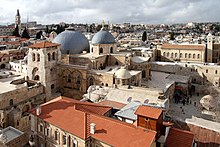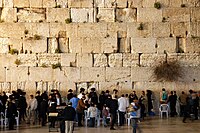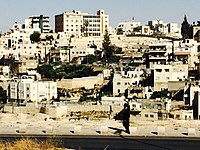Religious significance of Jerusalem
| Part of a series on |
| Jerusalem |
|---|
 |
The city of Jerusalem is sacred to many religious traditions, including the Abrahamic religions of Judaism, Christianity and Islam which consider it a holy city.[1] Some of the most sacred places for each of these religions are found in Jerusalem, most prominently, the Temple Mount/Haram Al-Sharif.[2]
In Judaism[edit]
Jerusalem has been the holiest city in Judaism and the ancestral and spiritual homeland of the Jewish people since the 10th century BCE.[3] During classical antiquity, Jerusalem was considered the center of the world, where God resided.[4]
The city of Jerusalem is given special status in Jewish religious law. In particular, Jews outside Jerusalem pray facing its direction, and the maaser sheni, revai and First Fruits must be eaten in Jerusalem. Any expansion of the city for these purposes must be approved by the Sanhedrin. [citation needed] Also, when the Temple in Jerusalem was standing, Jerusalem observed special laws regarding the Four Species on Sukkot, and the Shofar on Rosh Hashanah.
And God said: "Take now thy son, thine only son, whom thou lovest, Isaac, and go to the land of Moriah [Jerusalem]; and offer him there for a burnt-offering upon one of the mountains [Temple Mount] which I will tell thee of."
— Genesis 22:2
Jerusalem has long been embedded into Jewish religious consciousness. Jews have studied and personalized the struggle by King David to capture Jerusalem and his desire to build the Jewish temple there, as described in the Book of Samuel and the Book of Psalms. Many of King David's yearnings about Jerusalem have been adapted into popular prayers and songs.
Jerusalem appears in the Tanakh (Hebrew Bible) 669 times and Zion (which usually means Jerusalem, sometimes the Land of Israel) appears 154 times. The first section, the Torah, only mentions Moriah, the mountain range believed to be the location of the binding of Isaac and the Temple Mount in Jerusalem, and in later parts of the Tanakh the city is written explicitly. The Tanakh (or Old Testament), is a text sacred to both Judaism and Christianity. In Judaism it is considered the Written Law, the basis for the Oral Law (Mishnah, Talmud and Shulkhan Arukh) studied, practiced and treasured by Jews and Judaism for three millennia.[5] The Talmud elaborates in great depth the Jewish connection with the city.
According to the Hebrew Bible, the First Temple, at the site known as the Temple Mount today, was built by King Solomon and finished in 930 BC,[6] and Mount Moriah is where Abraham almost sacrificed his son and talked to God. When the Babylonians captured the city in 587/6 BC, they destroyed the temple and sent the Jews into exile.[7] That is, all worshiping was practiced in the temple and only the temple. From the Babylonian capture, Judaism was codified.[8] The Tanakh (Old Testament) laid the foundation for both Christianity and Islam.
-
Jews worship at the Western Wall
-
Member of the ultra-Orthodox Jewish community walking in front of Silwan. Many members of the ultra-Orthodox community travel to and live in Jerusalem
In Christianity[edit]

In Christian faith, Jerusalem's place in the life of Jesus gives it great importance, in addition to its place in the Old Testament. Jerusalem is the place where Jesus was brought as a child, to be "presented" at the Temple (Luke 2:22) and to attend festivals (Luke 2:41). According to the Gospels, Jesus preached and healed in Jerusalem, especially in the Temple courts. There is also an account of Jesus' "cleansing" of the Temple, chasing various traders out of the sacred precincts (Mark 11:15). At the end of each of the Gospels, there are accounts of Jesus' Last Supper in an "upper room" in Jerusalem, his arrest in Gethsemane, his trial, his crucifixion at Golgotha, his burial nearby and his resurrection and ascension. Jerusalem is generally considered the cradle of Christianity.[10]
The earliest Christians were outcast and used the Ichthys fish symbol as a way to know if someone was Christian. This would prevent prosecution or death from the Romans.[11] Christianity became more popular over time, but made a huge expansion when the Roman Emperor Constantine claimed Christianity as his religion and thus the religion of the Roman Empire.[12] Jerusalem is mostly important to Christianity because it is where Jesus Christ was brought occasionally as a child, preached to the poor in his adult life, crucified at the end of his life, and resurrected by God. The Church of the Holy Sepulchre is said to have been built over the location where Jesus was crucified and where the tomb was buried.[13] The Church of the Holy Sepulchre is generally considered the most important church in Christendom.[14]
In Christianity, the Jewish connection with the city is considered as the account of God's relationship with His chosen people—the original covenant—and the essential prelude to the events narrated in the New Testament, including both universal commandments (e.g. the Ten Commandments) and obsolete or Judaism-specific ones[citation needed]. In medieval times, Christians thought Jerusalem was the center of the world (Latin: umbilicus mundi, Greek: Omphalos), and was so represented in the so-called T and O maps[citation needed]. Byzantine hymns speak of the Cross being "planted in the center of the earth," and the imagery is tied to the concept of the Death and resurrection of Jesus being for the benefit of all mankind. Medieval maps of Europe usually placed the east ("orient")—Jerusalem—at the top, and this arrangement led to the use of the term "to orient" to mean to align a map with actual compass directions[citation needed].
-
Main entrance to the Church of the Holy Sepulchre; the church is generally considered the most important church in Christendom.[15]
-
The Cenacle on Mount Zion, claimed to be the location of the Last Supper and Pentecost. Bargil Pixner[16] claims the original Church of the Apostles is located under the current structure.
In Islam[edit]

In Sunni Islam, Jerusalem is the third-holiest city after Mecca and Medina.[17][18] Muslims believe that Muhammad was transported to Jerusalem during his Night Journey (Isra and Mi'raj).[19] The Qur'an describes how the prophet was taken by the miraculous steed Buraq from the Great Mosque of Mecca to Al-Aqsa ('"the farthest place of prayer") where he prayed, and then to visit heaven in a single night in the year 621.[20][19]
Glory be to the One Who took His servant ˹Muḥammad˺ by night from the Sacred Mosque to the Farthest Mosque whose surroundings We have blessed, so that We may show him some of Our signs. Indeed, He alone is the All-Hearing, All-Seeing.
Although the city of Jerusalem is not mentioned by any of its names in the Qur'an, it is mentioned in later Islamic literature as the place of Muhammad's Night Journey.[21] The story of Muhammad's ascension from Al-Aqsa Mosque was understood as relating to the Temple in Jerusalem (referred to as Bayt Al-Maqdis).[22] The Al-Aqsa Mosque is specified of being in Jerusalem in numerous hadith (prophetic traditions):
When the people of Quraish did not believe me (i.e. the story of my Night Journey), I stood up in Al-Hijr and Allah displayed Jerusalem in front of me, and I began describing it to them while I was looking at it.
The most holy spot [al-quds] on earth is Syria; the most holy spot in Syria is Palestine; the most holy spot in Palestine is Jerusalem [Bayt al-maqdis]; the most holy spot in Jerusalem is the Mountain; the most holy spot in Jerusalem is the place of worship [al-masjid], and the most holy spot in the place of worship is the Dome
Zayd ibn Thabit reports that the Prophet said, "How blessed is al-Sham! The Companions around asked: "Why is that?" The Messenger replied, "I see the angels of Allah spread their wings over al-Sham". lbn Abbas added, "and the Prophets lived in it. There is not a single inch in al-Quds (Jerusalem) where a Prophet has not prayed or an angel not stood".
— Tirmidhi hadith (compiled between 864/5-884)[citation needed]
The spiritual importance of Jerusalem in Islam is further emphasized due to its status as the first Qibla (direction of prayer). Islamic tradition holds that Muhammad led prayers towards Jerusalem until the 16th or 17th month after his migration from Mecca to Medina, when Allah directed him to instead turn towards the Kaaba in Mecca.[19][Quran 2:142-151] Another part of Jerusalem's significance and holiness to Muslims derives from its strong association with Abraham, David, Solomon, and Jesus. They are all regarded as Prophets of Islam and their stories are mentioned in the Qur'an.[26]
Today, the Temple Mount is dominated by three monumental structures from the early Umayyad period – the Dome of the Rock (691 CE), the Dome of the Chain (691-692 CE) and the al-Aqsa Mosque (705-715 CE).[27]
In Mandaeism[edit]


According to Jorunn J. Buckley, Mandaeans see themselves to be former Judeans based in Jerusalem and she believes Mandaeism to be of Judean or Israelite origin.[28] Mandaeans believe their chief prophet, John the Baptist, was born in Jerusalem. According to the Haran Gawaita, the Mandaeans loved the Lord Adonai until the birth of Jesus and had to flee Jerusalem due to persecution in the 1st Century CE.[29]: 3
James F. McGrath counts 45 mentions of Jerusalem in the Ginza Rabba and 84 in the Mandaean Book of John, noting that this is a higher frequency of mentions per page than the 274 mentions in the longer Babylonian Talmud. Accounts about Jerusalem mention John the Baptist, Miriai, Jacob and Benjamin, and visits by the uthras Anush Uthra and Hibil Ziwa. McGrath notes that the accounts of the destruction of Jerusalem in the Right Ginza portray it as justice for the persecution of Mandaeans, and suggests this to be evidence for a coherent proto-Mandaean community in Jerusalem prior to its destruction. This is similar to the Christian account that viewed the destruction of Jerusalem as vengeance for the persecution of Jesus and his followers. McGrath also adds that no other city in Mandaean literature is given as much attention as Jerusalem.[30]
See also[edit]
Notes[edit]
- ^ Zamfir, Ioana (2021-08-01). "Jerusalem in Motion. Images of Jerusalem in the Bible and Beyond". Review of Ecumenical Studies Sibiu. 13 (2): 160–174. doi:10.2478/ress-2021-0019.
- ^ “Al Aqsa Mosque, The.” GoJerusalem.com
- ^ Since the 10th century BCE:
- "Israel was first forged into a unified nation from Jerusalem some three thousand years ago, when King David probably seized the crown and united the twelve tribes from this city... For a thousand years Jerusalem was the seat of Jewish sovereignty, the household site of kings, the location of its legislative councils and courts. In exile, the Jewish nation came to be identified with the city that had been the site of its ancient capital. Jews, wherever they were, prayed for its restoration." Roger Friedland, Richard D. Hecht. To Rule Jerusalem, University of California Press, 2000, p. 8. ISBN 0-520-22092-7
- "The Jewish bond to Jerusalem was never broken. For three millennia, Jerusalem has been the center of the Jewish faith, retaining its symbolic value throughout the generations." Jerusalem- the Holy City, Israeli Ministry of Foreign Affairs, February 23, 2003. Accessed March 24, 2007.
- "The centrality of Jerusalem to Judaism is so strong that even secular Jews express their devotion and attachment to the city and cannot conceive of a modern State of Israel without it... For Jews Jerusalem is sacred simply because it exists... Though Jerusalem's sacred character goes back three millennia...". Leslie J. Hoppe. The Holy City:Jerusalem in the theology of the Old Testament, Liturgical Press, 2000, p. 6. ISBN 0-8146-5081-3
- "Ever since King David made Jerusalem the capital of Israel 3,000 years ago, the city has played a central role in Jewish existence." Mitchell Geoffrey Bard, The Complete Idiot's Guide to the Middle East Conflict, Alpha Books, 2002, p. 330. ISBN 0-02-864410-7
- "For Jews the city has been the pre-eminent focus of their spiritual, cultural, and national life throughout three millennia." Yossi Feintuch, U.S. Policy on Jerusalem, Greenwood Publishing Group, 1987, p. 1. ISBN 0-313-25700-0
- "Jerusalem became the center of the Jewish people some 3,000 years ago" Moshe Maʻoz, Sari Nusseibeh, Jerusalem: Points of Friction - And Beyond, Brill Academic Publishers, 2000, p. 1. ISBN 90-411-8843-6
- "The Jewish people are inextricably bound to the city of Jerusalem. No other city has played such a dominant role in the history, politics, culture, religion, national life and consciousness of a people as has Jerusalem in the life of Jewry and Judaism. Since King David established the city as the capital of the Jewish state c. 1000 BCE, it has served as the symbol and most profound expression of the Jewish people's identity as a nation." Basic Facts you should know: Jerusalem Archived 2013-01-04 at the Wayback Machine, Anti-Defamation League, 2007. Accessed March 28, 2007.
- ^ Korb, Scott. Life in Year One. New York: Riverhead books, 2010. print, 155. ISBN 978-1-59448-899-3.
- ^ List of Jewish prayers and blessings
- ^ Lacey, Ian. "Judaism as a Religious Tradition - Israel & Judaism Studies" Israel and Judaism Studies.
- ^ "Temple Mount, The," GoJerusalem.com.
- ^ Lacey, Ian. "Judaism as a Religious Tradition - Israel & Judaism Studies" Israel and Judaism Studies.
- ^ Beckles Willson, Rachel (2013). Orientalism and Musical Mission: Palestine and the West. Cambridge University Press. p. 146. ISBN 9781107036567.
- ^ Beckles Willson, Rachel (2013). Orientalism and Musical Mission: Palestine and the West. Cambridge University Press. p. 146. ISBN 9781107036567.
- ^ "Christian Fish Symbol, The." Religion Facts.
- ^ "One-Page Overview of Christian History, A" Religious Facts
- ^ "Holy Sepulchre." Encyclopædia Britannica. Encyclopædia Britannica Online Academic Edition.
- ^ Holt, Andrew (2019). The World of the Crusades: A Daily Life Encyclopedia [2 volumes]. ABC-CLIO. p. 57. ISBN 9781440854620.
was housed in the most important church in Christendom, the Church of the Holy Sepulchre.
- ^ Holt, Andrew (2019). The World of the Crusades: A Daily Life Encyclopedia [2 volumes]. ABC-CLIO. p. 57. ISBN 9781440854620.
was housed in the most important church in Christendom, the Church of the Holy Sepulchre.
- ^ Bargil Pixner, The Church of the Apostles found on Mount Zion, Biblical Archaeology Review 16.3 May/June 1990 [1]
- ^ Middle East peace plans by Willard A. Beling: "The Aqsa Mosque on the Temple Mount is the third holiest site in Sunni Islam after Mecca and Medina".
- ^ Third-holiest city in Islam:
- Esposito, John L. (2002). What Everyone Needs to Know about Islam. Oxford University Press. p. 157. ISBN 0-19-515713-3.
The Night Journey made Jerusalem the third holiest city in Islam
- Brown, Leon Carl (2000). "Setting the Stage: Islam and Muslims". Religion and State: The Muslim Approach to Politics. Columbia University Press. p. 11. ISBN 0-231-12038-9.
The third holiest city of Islam—Jerusalem—is also very much in the center...
- Hoppe, Leslie J. (2000). The Holy City: Jerusalem in the Theology of the Old Testament. Michael Glazier Books. p. 14. ISBN 0-8146-5081-3.
Jerusalem has always enjoyed a prominent place in Islam. Jerusalem is often referred to as the third holiest city in Islam...
- Esposito, John L. (2002). What Everyone Needs to Know about Islam. Oxford University Press. p. 157. ISBN 0-19-515713-3.
- ^ a b c Buchanan, Allen (2004). States, Nations, and Borders: The Ethics of Making Boundaries. Cambridge University Press. ISBN 0-521-52575-6.
- ^ Brooke Olson Vuckovic. Heavenly journeys, earthly concerns (2004). Routledge.
- ^ Historic Cities of the Islamic World edited by Clifford Edmund Bosworth P: 226
- ^ "The Farthest Mosque must refer to the site of the Solomon's Temple in Jerusalem on the hill of Moriah, at or near which stands the Dome of the Rock... it was a sacred place to both Jews and Christians... The chief dates in connection with the Temple in Jerusalem are: It was finished by Solomon about 1004 BCE; destroyed by the Babylonians under Nebuchadnezzar about 586 BCE; rebuilt under Ezra and Nehemiah about 515 BCE; turned into a heathen idol temple by one of Alexander the Great's successors, Antiochus Epiphanes, 167 BCE; restored by Herod, 17 BCE to 29; and completely razed to the ground by the Emperor Titus in 70. These ups and downs are among the greater signs in religious history." (Yusuf Ali, Commentary on the Koran, 2168.)
- ^ As quoted in Abu Bakr Muhammad ibn Ahmad al-Wasiti's Fada'il Bayt al-Muqaddas (c.1019)
- ^ Jerusalem for the Three Monotheistic Religions. A Theological Synthesis, Alviero Niccacci Archived 2012-10-08 at the Wayback Machine
- ^ The Ḥaram of Jerusalem, 324-1099: temple, Friday Mosque, area of spiritual power, by Andreas Kaplony, 2002
- ^ El-Khatib, Abdallah (2001-05-01). "Jerusalem in the Qur'a¯n". British Journal of Middle Eastern Studies. 28 (1): 25–53. doi:10.1080/13530190120034549. ISSN 1353-0194. S2CID 159680405.
The Quran speaks about Hebrew patriarchs and prophets such as Abraham, Isaac, David, Solomon, and Jesus, who lived in the city or passed through it.
- ^ "Temple Mount/Al Haram Ash Sharif | Middle East Attractions". Lonely Planet. Retrieved 2022-01-25.
- ^ Buckley, Jorunn Jacobsen (2010). Turning the Tables on Jesus: The Mandaean View. In Horsley, Richard (March 2010). Christian Origins. ISBN 9781451416640.(pp94-111). Minneapolis: Fortress Press
- ^ Drower, Ethel Stefana (1953). The Haran Gawaita and the Baptism of Hibil-Ziwa. Biblioteca Apostolica Vaticana.
- ^ McGrath, James F. (2013). "Polemic, Redaction, and History in the Mandaean Book of John: The Case of the Lightworld Visitors to Jerusalem". ARAM Periodical. 25 (1&2): 375–382.
References[edit]
- Ioana Zamfir (2021), "Jerusalem in Motion. Images of Jerusalem in the Bible and Beyond," in Review of Ecumenical Studies.
- Ali, Abdullah Yusuf (1991). The Holy Quran. Medina: King Fahd Holy Qur-an Printing Complex.



![Main entrance to the Church of the Holy Sepulchre; the church is generally considered the most important church in Christendom.[15]](http://upload.wikimedia.org/wikipedia/commons/thumb/b/bf/Jerusalem_Holy_Sepulchre_BW_24.JPG/200px-Jerusalem_Holy_Sepulchre_BW_24.JPG)
![The Cenacle on Mount Zion, claimed to be the location of the Last Supper and Pentecost. Bargil Pixner[16] claims the original Church of the Apostles is located under the current structure.](http://upload.wikimedia.org/wikipedia/commons/thumb/a/ac/Jerusalem_Cenacle_BW_5.JPG/133px-Jerusalem_Cenacle_BW_5.JPG)